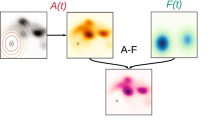A method of studying the dynamics of visual attention in humans at different stages of examining and recognizing complex images is described. The characteristics of the method include presenting dynamically formed whole images and distractors in the foveal area of the visual field. Experimental data on the effects of acclimation to distractors, the bimodal distribution of fixation duration when distractors are used, and the relationship between the effect of the distractor and the complexity of the target image are presented. Most EEG leads, except the occipital leads, showed significant decreases in the latent period of the P350 component of fixation-linked potentials on simultaneous presentation of whole images and distractors. The potential for using these results to create work-oriented tests for assessment of the state of visual attention in human operators without interfering with their work is discussed.
Similar content being viewed by others
References
I. N. Baranov-Krylov, V. T. Shuvaev, and I. E. Kanunikov, “Characteristics of the activation in the parietal areas of the cortex in humans in different forms of visual attention,” Ros. Fiziol. Zh., 92, No. 2, 178–191 (2006).
B. V. Burdin, M. V. Mikhailyuk, I. G. Sokhin, and M. A. Torgashev, “Use of virtual 3D models for experimental processing of on-board piloting operations performed by anthropomorphic robots,” Robototekh. Tekhnich. Kibernet., No. 1, 42–46 (2013).
B. M. Vladimirskii, A. B. Gorstko, and Ya. M. Erusalimskii, Mathematics. A General Course, Lan’, Rostov-on-Don, (2008).
V. N. Koroi, E. V. Aslanyan, O. M. Bakhtin, et al., The Human Factor and Safety of Aviation Transport: Mechanisms of Formation and Methods for the Diagnosis of the Functional State of Human Operators, IPK KIBI Media Center, Southern Federal University (2014).
A. L. Yarbus, The Role of Eye Movements in the Process of Vision, Nauka, Moscow (1965).
U. Ahlstrom and F. J. Friedman-Berg, “Using eye movement activity as a correlate of cognitive workload,” Int. J. Industr. Ergonom., 36, No. 7, 623–636 (2006).
M. A. Carrasco, “Visual attention: the past 25 years,” Vision Res., 51, No. 13, 1484–1525 (2011).
A. Deplancke, L. Madelain, A. Chauvin, et al., “Infl uence of near threshold visual distractors on perceptual detection and reaching movements,” J. Neurophysiol., 104, No. 4, 2249–2256 (2010).
O. Dimigen, W. Sommer, A. Hohlfeld, et al., “Coregistration of eye movements and EEG in natural reading: analyses and review,” J. Exp. Psychol. Gen., 140, No. 4, 552–572 (2011).
J. Gobell and M. Carrasco, “Attention alters the appearance of spatial frequency and gap size,” Psychol. Sci., 16, No. 8, 644–651 (2005).
S. T. Graupner, S. Pannasch, and B. M. Velichkovsky, “Saccadic context indicates information processing within visual fixations: Evidence from event-related potentials and eye-movements analysis of the distractor effect,” Int. J. Psychophysiol., 80, No. 1, 54–62 (2011).
S. T. Graupner, B. M. Velichkovsky, S. Pannasch, and J. Marx, “Surprise, surprise: Two distinct components in the visually evoked distractor effect,” Psychophysiology, 44, 251–261 (2007).
J. M. Henderson and G. L. Pierce, “Eye movements during scene viewing: Evidence for mixed control of fixation durations,” Psychon. Bull. Rev., 15, No. 3, 566–573 (2008).
I. Hooge and C. J. Erkelens, “Adjustment of fixation duration in visual search,” Vision Res., 38, No. 9, 1295–1302 (1998).
T. I. Koltunova and L. N. Podladchikova, “Distractor effect at initial stages of recognition depends on visual image properties,” J. Integr. Neurosci., 12, No. 1, 91–101 (2013).
N. Lavie, “The role of perceptual load in visual awareness,” Brain Res., 1080, No. 1, 91–100 (2006).
S. Mathan, A. Smart, T. Ververs, and M. Feuerstain, “Towards an index of cognitive efficacy,” in: 32nd Ann. Int. Conf. IEEE EMBS (2010), pp. 6595–6598.
M. Nystrom and K. Holmqvist, “An adaptive algorithm for fixation, saccade, and glissade detection in eyetracking data,” Behav. Res. Methods, 42, No. 1, 188–204 (2010).
L. N. Podladchikova, D. G. Shaposhnikov, T. I. Koltunova, et al., “Temporal dynamics of fixation duration, saccade amplitude, and viewing trajectory,” J. Integr. Neurosci., 8, No. 4, 487–501 (2009).
L. N. Podladchikova, D. G. Shaposhnikov, A. V. Tikidgji-Hamburyan, et al., “Model-based approach to study the mechanisms of complex image viewing,” J. Opt. Mem. Neural Netw., 18, No. 2, 114–121 (2009).
M. Pomplun, E. M. Reingold, and J. Shen, “Peripheral and parafoveal cueing and masking effects on saccadic selectivity in a gaze-contingent window paradigm,” Vision Res., 41, No. 21, 2757–2769 (2002).
C. M. Priviterra and L. Stark, “Scanpath theory, attention and image processing algorithms for prediction of human eye fixations,” in: Neurobiology of Attention, Elsevier Academic, Los Angeles (2005), pp. 296–299.
E. M. Reingold and D. M. Stampe, “Saccadic inhibition in voluntary and refl exive saccades,” J. Cogn. Neurosci., 14, No. 3, 371–388 (2002).
I. Rybak, V. Gusakova, A. Golovan, et al., “Attention-guided recognition based on ‘What’ and ‘Where’ representations: a behavioral model,” in: Neurobiology of Attention, Elsevier Academic, Los Angeles (2005), pp. 663–670.
C. Tandonnet, D. Massendari, and F. Vitu, “When larger visual distractors become less disruptive: Behavioral evidence for lateral inhibition in saccade generation,” J. Vision, 12, No. 4, 1–11 (2012).
R. Walker, H. Deubel, W. X. Schneider, and J. M. Findlay, “Effect of remote distracters on saccade programming: Evidence for an extended fixation zone,” J. Neurophysiol., 78, No. 2, 1108–1119 (1997).
D. B. Walther and C. Koch, “Attention in hierarchical models of object recognition,” Prog. Brain Res., 165, 57–78 (2007).
Author information
Authors and Affiliations
Additional information
Translated from Rossiiskii Fiziologicheskii Zhurnal imeni I. M. Sechenova, Vol. 101, No. 10, pp. 1202–1212, October, 2015.
Rights and permissions
About this article
Cite this article
Koltunova, T.I., Podladchikova, L.N., Shaposhnikov, D.G. et al. Dynamics of the Duration of Gaze Fixation and Event-Related Potentials on Presentation of Fading-In Images and Distractors. Neurosci Behav Physi 47, 321–327 (2017). https://doi.org/10.1007/s11055-017-0400-8
Received:
Revised:
Published:
Issue Date:
DOI: https://doi.org/10.1007/s11055-017-0400-8



